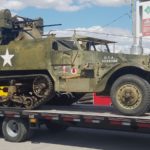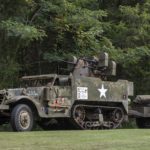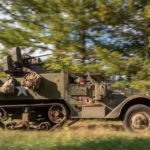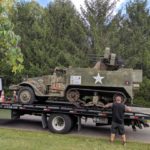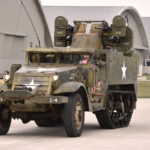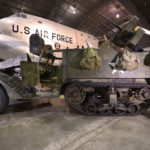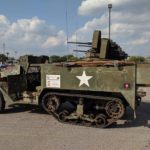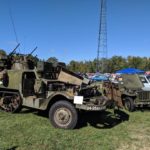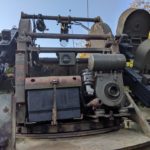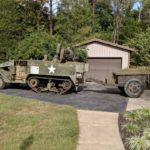History
Half-tracks
Half-tracks are light armored vehicles with conventional wheels in the front and a continuous track in the rear providing excellent mobility in difficult terrain. The U.S. Army developed and deployed half-tracks across the globe for use as personnel carriers, anti-aircraft platforms and mobile artillery. Originally built as a M16 at the White Motor Company factory in Cleveland, Ohio, the African Queen was converted to a M16A2 with the addition of a troop door, improved weapons, communication and electrical systems and troop seats in the gunners compartment. Half-tracks were used extensively by the U.S. and her allies in the WWII European theater, the Korean War, and the Vietnam War.
Do you have a veterans story or pictures you would like to submit?
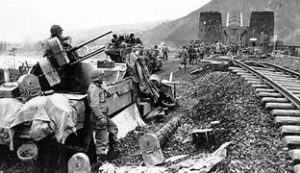
U.S. M16 half-tracks provided critical support during the Allied breakout across the Remagen Bridge into Nazi Germany in 1945.
RECovery
SAVING THE HALF-TRACK
The African Queen is a 1943 White M16A2 WWII anti-aircraft half-track recovered from the East Africa desert in 2006 by Lieutenant Colonel (LTC) Mark Koloc, US Army (RET). This rare and historic vehicle was discovered in the Horn of Africa while LTC Koloc was serving there. It was abandoned by the French Foreign Legion in the late 1950’s. The French received the half-track from US forces in Korea in 1953 and immediately shipped her to Indo-China (Vietnam) for combat service. Shipped from Indo-China to Djibouti Africa in 1954, she was used by the French Foreign Legion until she was damaged, towed into the desert and abandoned.
After arriving in Africa, LTC Koloc discovered the Queen while out with his team on a 5 mile acclimation run. Recognizing her through the surrounding thorn bushes as a WWII Half-track, LTC Koloc committed to recovering the Queen from the desert and shipping her back to the US. Working with a French liaison officer, the vehicle was purchased, towed in from the desert and the necessary paperwork completed to ship the Queen back to the US. There were both document and financial challenges, but they were overcome and she finally made it home in 2006. LTC Koloc owes a debt of gratitude to several fellow enthusiasts working for Kellogg Brown and Root (KBR) who volunteered their time and resources in recovering her from the desert and assisting LTC Koloc in prepping her for shipment back to the US.
See more pictures of the African Queen Half-track
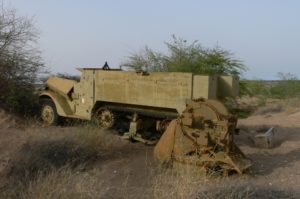
Abandoned 50 Years: Time had taken its toll and many parts laid scattered or buried beside the vehicle such as the Maxson turret in the foreground. One of the turret rings was so reclaimed by the sand, it could only be located by using a mine detector set.
PRESERVATION
KEEPING IT ORIGINAL
After getting the Queen home in 2006, LTC Koloc utilized the internet to source the equipment that would have been onboard the Queen during the Korean War. Numerous acquisitions included original working radios, turret generator, gun sight, and an original partition to replace the one modified by French. Additional items include original unused tracks, spare .50-caliber barrels, original tombstone ammo cans, crew and turret weapons, tools, field gear, and more.
Most recently the Maxson gun turret was restored to operating condition by rebuilding the gearboxes, fabricating new wiring, repairing rust frozen linkage, and sourcing the original Amphenol connectors and Packard slip ring. Fans and supporters all over the world have tracked down rare items for the project to purchase or have simply donated them to the African Queen project.
Our goal is to use the African Queen as an educational platform via exhibitions and programs and to celebrate the sacrifices made by the “Greatest Generation” during WWII and Korea.
Learn more about the African Queen Preservation Program
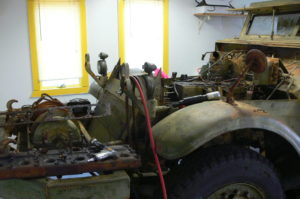
Undergoing Preservation: Initial tear-down work revealed several surprises like scorpion shells inside the drive system and historical graffiti on the rear storage box.
Conservation
OUR WORK CONTINUES
This has been an eventful year. Our greatest challenges these past months include the continuation of the preservation project and the establishment of the African Queen Project as an Educational Nonprofit. We are now seeking funding support for the African Queen Project. Since 2018 $35K has been invested on the following items:
-
- Rebuilt track suspension system and rehabilitated bogies.
- Installed new tracks, bushings, and bearings.
- Rewired complete electrical system to include modified original WWII wire harness.
- Restored switches, gauges, dashboard, taillights, and headlights.
- Installed working radios, intercom boxes, and turret slip-ring.
- Rebuilt Bendix hydraulic/electric brake systems and hydrovac power booster.
- Restored front axle and suspension system to include hydraulic shock absorbers.
- Replaced rusted hinges on hatch covers and trays.
- Fabricated new canvas straps using original WWII hardware.
- Purchased four replica .50 Cal machine guns with gas firing system.
Current initiatives and efforts:
-
- Acquisition of a trailer and tow vehicle. ($55K)
- Preservation of the Half-track ammunition trailer. ($2K)
- Replacement of the original, 68 year-old, Michelin solid rubber combat tires. ($1K)
- Restoration of the batwing turret armor. ($1K)
- Fabrication of a canvas cover to protect the turret and weapons. ($2K)
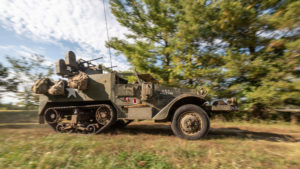
“Recognizing heroes like my father Tony, a combat engineer who served during the Korean War is a African Queen Project initiative. I lost my dad in 2003, while serving in Afghanistan and I feel his presence daily as my preservation efforts with this historic vehicle and its unique history continues.”
LTC Mark A.R. Koloc
Photo courtesy of G. Kessler: www.kesslerphotography.com
Images of the African Queen Half-track
LEarn More
Other African Queen Vehicles
1942 Ford GPW Jeep
1953 M-37 Dodge Truck
1953 Daimler Ferret
African Queen Project Programs
Education Programs
Veterans Programs
Preservation Programs
Donate to the African Queen Project
